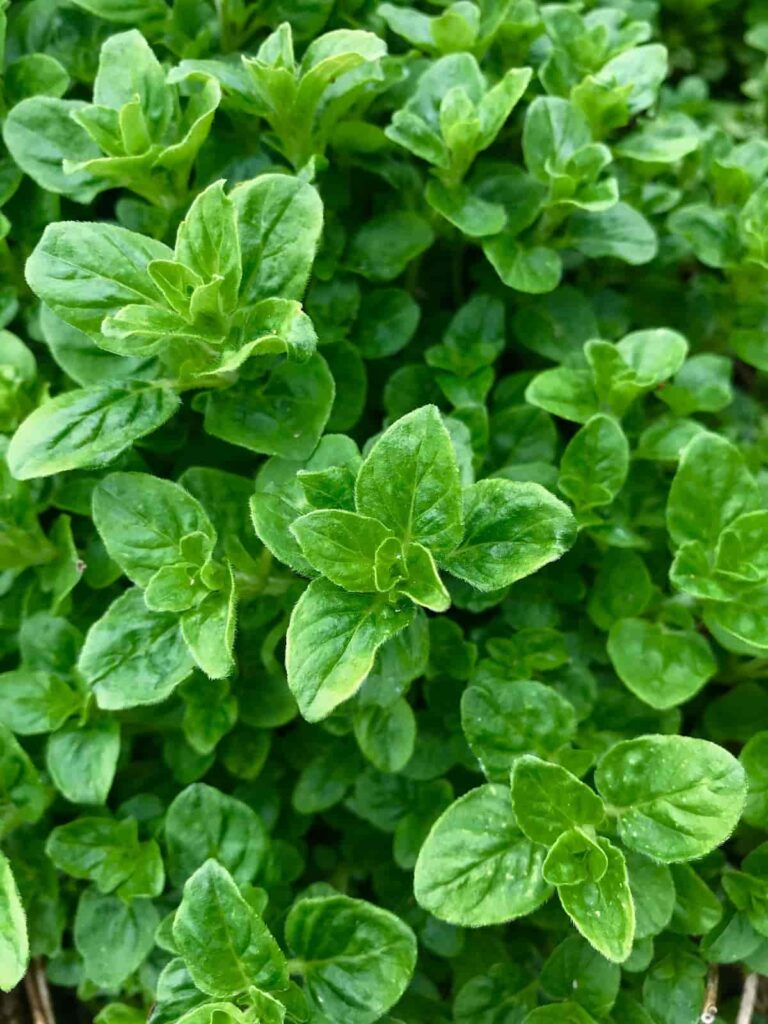Growing Oreganos in your garden is a great way to get this amazingly fresh herb throughout the year. Growing Oregano from seeds is also very easy. You can grow culinary herbs if your home has a sunny window or a small outdoor garden. You can grow them from seeds, or Oregano plants are usually available in nurseries. Oregano is a low-maintenance perennial herb, which means you can plant it once and cut it for years.
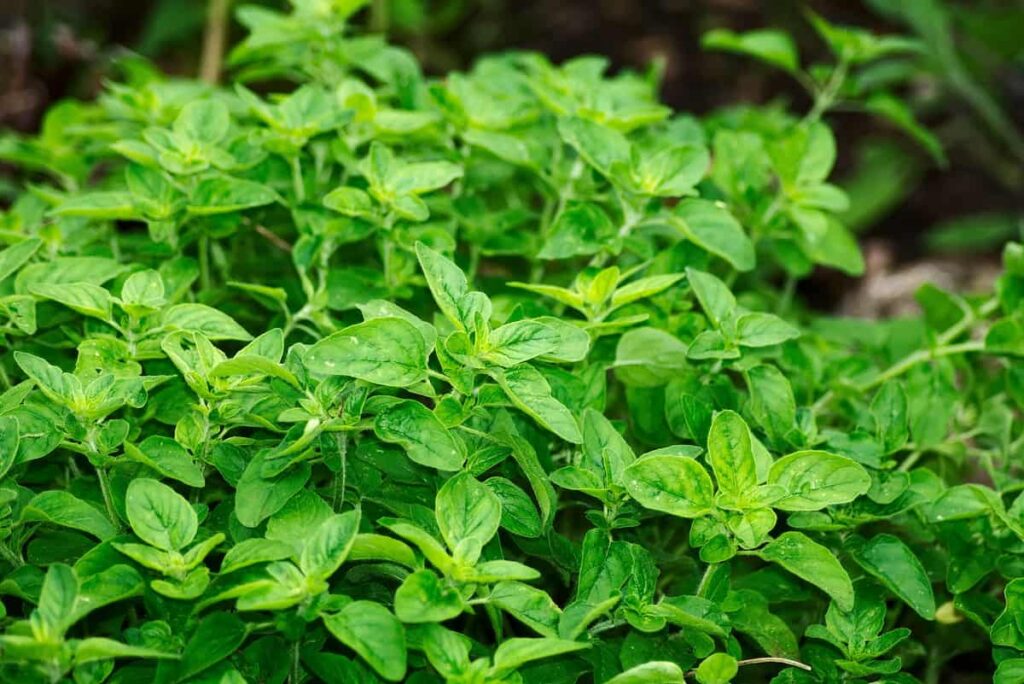
How to grow Oregano from seed to harvest
How long does Oregano take to grow from seeds?
- You can easily grow Oregano from seeds. You should start seeds indoors before the last expected frost in your area. There is no need to cover the seeds of Oregano with soil. It takes about 1 to 2 weeks for the Oregano seeds to germinate and then up to 4 months for the plant to develop into a full plant. Start indoors in a plug tray from late winter to mid-spring. Starting indoors is more consistent than direct sowing. Oregano seeds are like dust, so handle them carefully.
- Oregano is about five or six years old; usually, one crop is harvested in the first year and two in the following years. Oregano is a very hardy herb that doesn’t require much care. Watering or fertilizing too much can have harmful effects on the plant. It usually grows easily when supplied with sun, heat, and well-drained soil. Oregano plants reach maturity 80 to 90 days after seeding, but you can start harvesting leaves in 6 to 8 weeks. You can harvest Oregano leaves by pinching or snipping a branch just above a leaf node, using care not to cut back more than one-third of the branch or plant at a time.
Germinating Oregano seed
- You should start Oregano seeds indoors before the last expected frost in your area. Completely wet the sphagnum moss, and wring out the excess water with your hands. Combine the Oregano seeds with sphagnum moss, pour the mix into a plastic bag, and seal it. Refrigerate the sealed bag at temperatures between 2 to 8°C for a week. This cooling period helps bring Oregano seeds out of their dormant state by simulating winter.
- Fill the seed tray with a potting mix, and spread the seed and moss combination on the surface. Gently water the seed tray. Place the seed tray in a sunny place to sprout. Sow takes 10 to 15 days for the Oregano seeds to germinate. Sow seeds at 21°C for maximum germination. Seeds grow best in light.
- Prepare a pot or outdoor position when the second set of leaves appears. Fill 12-inch pots with potting soil. If planting in outdoor beds, choose a place with good drainage and full sun. Gently water the seedlings and carefully remove them from the seed tray. Plant seedlings into prepared pots, gently covering the roots with a potting mix. Place the pots indoors in a sunny window, or there is no danger now after the frost outside. Set them in holes at a distance of 12 inches, and carefully cover the roots with a potting mix.
In case you missed it: How to Build Raised Bed Garden from Scratch: Plan, and Design for Beginners
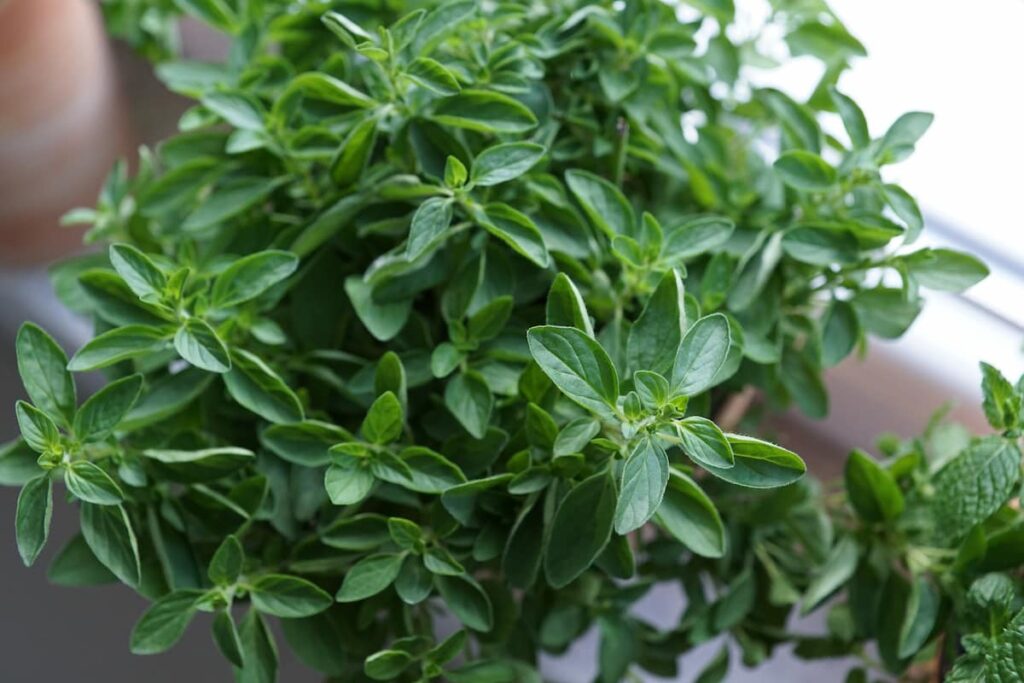
When should you harvest Oregano?
Harvest the Oregano once the stems are at least four inches long. Let them be about eight inches long, then cut to 2/3 of the plant. Don’t worry if you’ve cut the Oregano too much. Regular trimming encourages new growth. Oreganos are best harvested before flowering in spring and early summer. After flowering, the taste changes, and it’s not that good.
Growing Oregano from cutting
You can also grow Oregano through cuttings. Take a 7 to 12 centimeters long stem cutting from a healthy plant, remove the leaves from the bottom half and place the cuttings in water so the leaves are above the water. To avoid direct sunlight, place your containers in a well-lit place. Put the cutting into either water or peat moss and vermiculite mixture. If you choose this option, change the water every two to three days. If planting in a soilless mix, keep it moist. Place the cuttings in a brightly lit area but not in direct sunlight.
Should you let Oregano flower?
When Oregano plants flower, they have reached maturity and are ready to produce seeds. You can remove flowers or allow plants to prevent them from seeding too fast. When growing Oregano, it is necessary to cut it, as it ensures that the plant thrives. You’ll often want to cut out your Oregano during the spring and summer growing seasons to encourage new growth. You’ll need to remove dead flowers and stems once the growing season is over.
The best month to plant Oregano seeds
Growing Oregano from seeds is also very easy. You can grow Oreganos from seeds and plant them indoors in plastic starter pots in early spring, around March and April. If you don’t want to grow Oregano from seeds, you can grow from cutting or container plants purchased in your garden center. The typical Oregano can be started with seeds sown indoors from February to May. Fill a small pot with seed compost and sow some seeds on the surface. Water and place in a propagator to germinate.
In case you missed it: Backyard Gardening Basics: Tips and Ideas What Every Gardener Should Know
Should you cut back on Oregano?
- Oregano grows rapidly and benefits from mid-season pruning immediately after flowering. It will inspire even more of this tasty new growth. This is how the Oregano looks before cutting as dense as it can be with the straggly stems below. Use scissors or garden shears to remove stems from the plant. Cut back just above the growth node or set of leaves. Pruning allows the plant to branch out of the cut area. If there is dust or mulch on them, rinse the stems lightly.
- Keep the plants compact by trimming the growth of the plants after the flowers fade in the summer, then boost the plants growing in pots by applying liquid fertilizer. Cut the dead stems back to the base in the winter. Plants don’t like to get too wet in the winter, so place the pots in the shelter space and lift them at the feet of the pot so that excess water can flow.
- Oregano is a tasty herb that is a perfect choice for any herbal garden. When growing Oregano, it is necessary to cut it, as it ensures that the plant thrives. You’ll often want to cut out your Oregano during the spring and summer growing seasons to encourage new growth. Once the growing season is over, you’ll need to remove dead flowers and stems.
Water requirement for growing Oregano
- Excessive water can also cause the plant to uproot itself, as the soil is easily washed away when it does not have a solid root structure. Plan to water your Oregano plants every few days or even daily. Oregano doesn’t require as much water as most herbs as the amount of water depends on many variables, only water when the soil feels dry to the touch. Remember that it is better to water well and less often.
- Oregano plants will need to be watered every 2 to 3 days when you plant them for the first week or two. The watering rate may slow once every 1 to 2 weeks in the spring. You may need to water the Oregano once or twice a week in the summer to prevent it from drying.
- Oregano doesn’t need much water. Oregano prefers dry soil. Watering the Oregano 2 to 3 times per week is usually enough. Water the indoor Oregano a little more frequently, but avoid making the soil soggy. Oregano requires just an inch of water per week and tolerates moderate drought. Allow the soil to dry between the water. Too much water can cause root rot and other problems.
What can you not plant with Oregano?
- Basil, Chives, Cilantro, and Mint all prefer soil moisture levels higher than Oregano plants need. If you plant them close to each other, it is better to do so by planting them in separate containers.
- Although Oregano combines well with numerous vegetables and herbs, you should avoid growing it around plants with heavy water requirements. This includes crops that grow best during cold weather, such as cruciferous vegetables. You don’t plant Oregano too close to Cabbage, Broccoli, or Collard. You may also avoid varieties of herbs that are similar to moist soil, such as Celery and some varieties of Basil.
In case you missed it: How to Grow Evergreen Hedge Plants: Best, Easiest, Fastest, and Low-Maintenance for Borders and Privacy
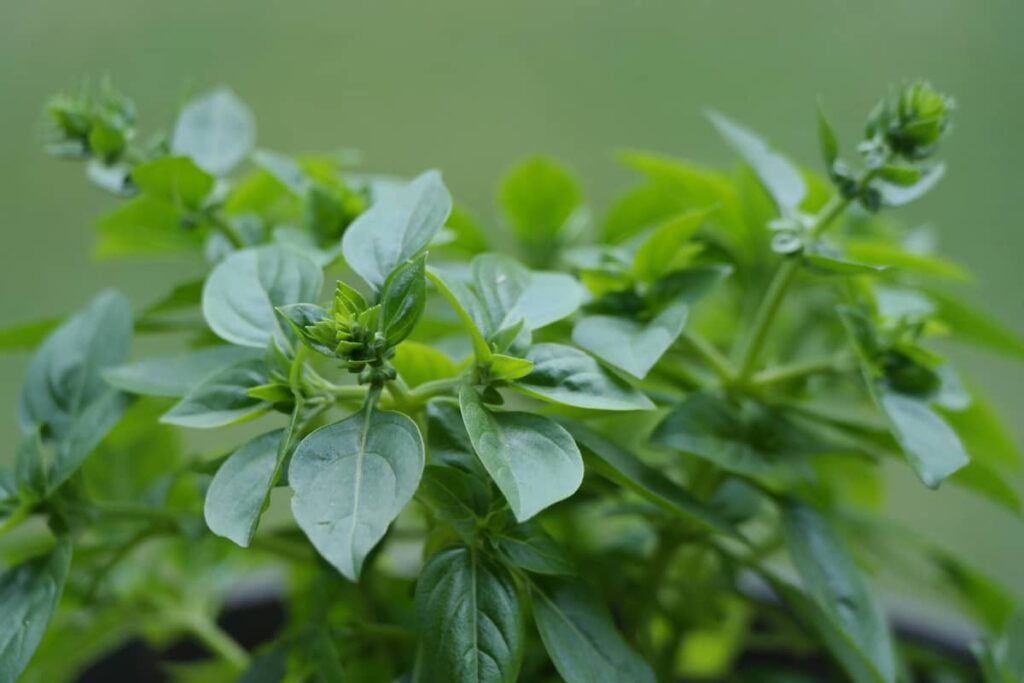
Will Oregano survive winter?
- The colder your climate, the more your plants risk not surviving the winter. Some cold hardy herbs like Oregano are very well adapted. In frost areas, they grow as perennials, become dormant in the winter and return with new growth in the spring.
- Do not trim too little under the stems (a slight trim of the upper leaves is enough), as the plants need time to recover before the cold season arrives, and the small tender shoots produced by severe pruning will not be kind enough to bathe in the frost.
- Cold-hardy herbs, such as Oregano, can often survive cold winter temperatures while continuing to produce flavorful leaves, as long as they are provided with protection or grown indoors.
Spacing between Oregano plants
Space Oregano plants in a sunny space 8 to 10 inches apart with fertile, well-drained soil with a pH of 6.5 to 7.0. If growing in warmer climates, offer partial shade. Plant the Oregano in your garden eight to 10 inches apart. The Oregano is two feet long and extends to about 18 inches. If you’re planting Oregano in a container, make sure the pot is about 12 inches in diameter, as the Oregano is a great grower. Seeds should be pressed slightly into the soil, as they need light to grow.
Sun requirement for growing Oregano
- Oregano loves the sun, so ensure your place has the full sun for a strong taste. If growing in warmer climates, offer partial shade. Oregano performs well in the full sun, but the taste intensifies when it gets a full day of sunshine. The Oregano will grow well indoors, but the plant must get proper heat and sunlight. Do not give too much water to Oregano.
- The Oregano thriving outdoors with plenty of direct sunlight must be watered 2 to 3 times per week. It is unnecessary to water the Oregano daily unless you live in a particularly warm climate or your Oregano is planted where it never gets shade. Providing at least 10 hours of light exposure is important when growing this herb in the indirect or partial sun. It is also important to understand that when it is grown in full sunlight, its taste and aroma are far more intense. Oregano will also grow well in indirect sunlight.
How many Oregano seeds are in a hole?
Oregano seeds are like dust, so handle them carefully. Prepare containers or plug trays using a sterile seed starting mixture, and water the soil. Then try to distribute small seeds evenly on the soil surface. For herbs such as Dill, Oregano, or Parsley, you can either plant 2 to 3 seeds per hole and later thin to 1 or plant more than one seed per hole and let them all mature together.
In case you missed it: How to Make Rose Plants Bushy and Flowers Bigger: Propagation, Fertilizers, Pruning, Planting, and Care
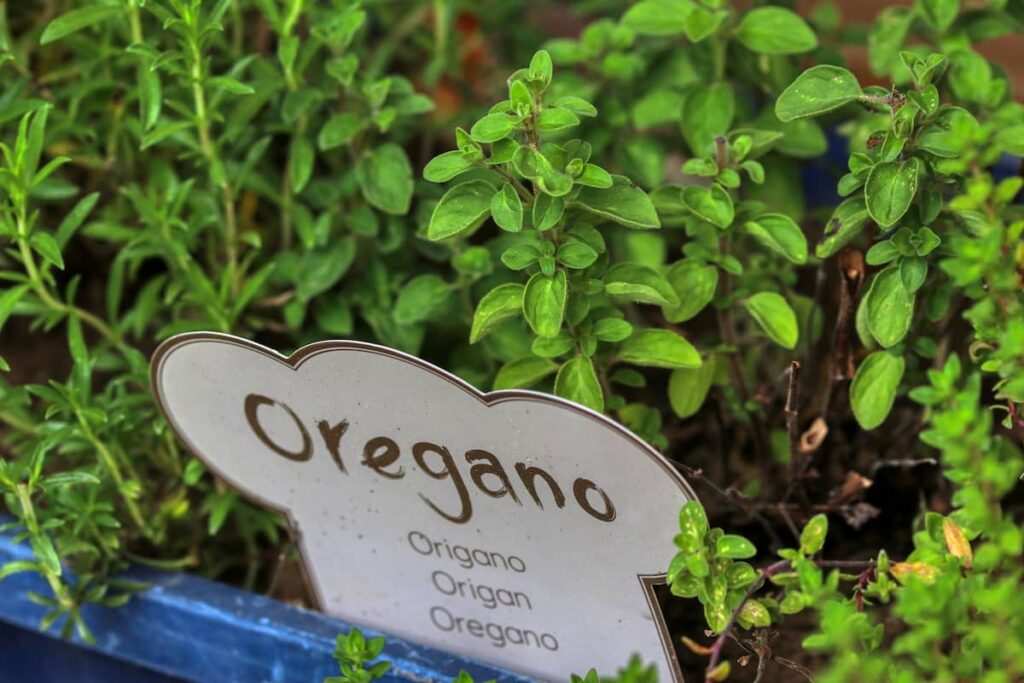
Growing Oregano from seed indoors
Like Thyme, Oregano is a great plant for hot, dry, and sunny places. It can be given enough sunlight indoors, such as in a window facing the south or west. Oregano can be sown from seeds or a nursery plant at any time when grown indoors. It is easy to take care of an Oregano plant that requires at least six to eight hours of sunlight. A bright, southern exposure window is perfect for growing Oregano, or you can use plant light.
Fertilizer requirement for growing Oregano
- Oregano usually does not require fertilizer, as it can thrive in poor soil. Large amounts of nitrogen can alter the taste of herbs. Space Oregano plants in a sunny space 8 to 10 inches apart with fertile, well-drained soil with a pH of 6.5 to 7.0. If growing in warmer climates, offer partial shade. Give fertile soil to young plants to take root by adding several inches of aged manure or other rich organic matter to your native soil.
- You should fertilize the Oregano plants every two weeks with diluted water-soluble food. Taking care of herbs is so easy that only a few items must be remembered when learning to grow Oregano indoors.
- If you added fertilizer to the garden bed in early spring, the fertilizer requirements for Oregano during the growing season are almost negligible. However, container-grown Oreganos will need to be regularly fertilized as plants will soon eliminate nutrients in the soil.
Soil requirement for growing Oregano
- Oregano grows best in full sunshine and well-drained soil. However, it will also grow in rocky soil. Oregano can thrive in areas with harsh growing conditions. If you have swampy or heavy soil, put the Oregano in a container or raised bed. Plant Oregano in light, well-drained soil.
- Sandy loam is ideal for growing Oregano. If the soil is moist with much organic matter, Oregano will not perform as well as in well-drained, light, dry soil. In addition, a little acidic is best for neutral soil pH.
- Whether you grow your Oregano in a pot or garden, it will flourish when the soil pH is between 6.0 and 8.0. This means that it is an adaptable plant that can live in soil that is a bit acidic to very alkaline.
Why are my Oregano leaves drooping?
- Your Oregano plant can wilt with too much water or too little. Remember that a wilting Oregano plant doesn’t necessarily need water. Sometimes Oregano plants wilt when they have too much water. Always check the soil dryness to determine if you should give some water to the Oregano plant.
- Symptoms of excessive water use include yellow or black leaves. Bubbles can appear on the stems of an over-water Oregano plant. The fungus can appear on the plant’s roots or leaves if given more water. Stunted growth can occur if your Oregano gets too much water.
In case you missed it: How to Design a Bamboo Garden: Ideas for Layout and Planting from Cuttings
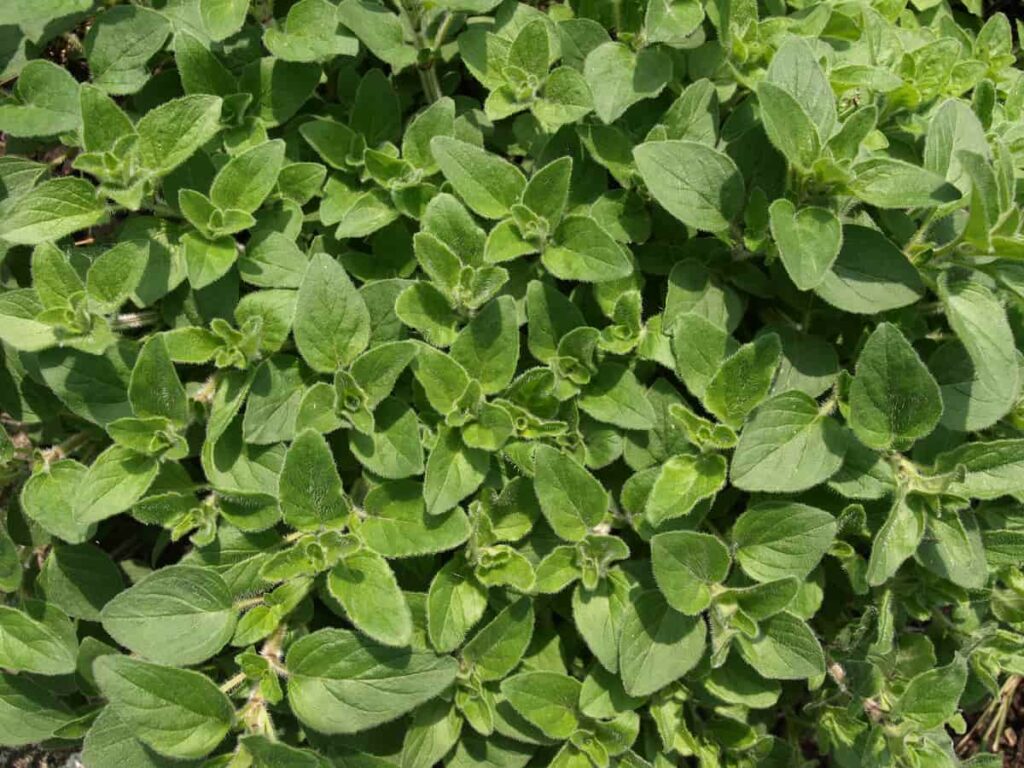
Growing Oregano in pots
- Many culinary herbs grow well in containers, and Oregano is one of them. You can grow Oregano well in pots and small spaces with plenty of sunlight and water. It’s a great container plant for beginners, starting with just a patio garden.
- Oregano is a perennial herb that is exceptionally easy to grow and thrives under the same conditions as Thyme. When growing Oregano indoors, you can use a 12-inch pot, which will assume a more trailing habit than the plants found on plants growing outside in the garden.
- You can grow it into a medium-sized 8- to 12-inch-deep pot with a similar spread. Some low-growing varieties, such as creeping Oregano and golden Oregano, can be grown in shallow but wide 6- to 8-inch-deep pots. Plant tall varieties such as Lebanese and Mexican Oreganos in a pot of at least 12 inches.
Conclusion
It’s not hard to grow Oregano from seeds, but it’s very easy to grow quickly in the water with small cuttings and clippings. Since Oregano is so delicious, healthy, and easy to grow, it’s important in every herb garden. Oregano is a low-care herb that performs well in the garden and indoors if given the right conditions. Growing Oregano in a pot on the window will give you a supply of fresh herbs throughout the year.
- Management Pests and Diseases in Your Cotton Field
- Sheep Farming Business Plan for Beginners
- Aquaponic Farming at Home: A Step-By-Step Guide
- Profitable Village Farming Business Ideas in 2024
- High-Yield Aquaculture: Fast-Growing Fish for Farming
- Effective Fish Pond Construction Techniques for Beginners
- Irrigation and Water Management in Pineapple Farming
- Blossom to Harvest: Mastering Flowering and Pollination in Papaya Farming
- Pig Fattening Essentials: From Selection to Sale for Beginners
- Raising Wagyu Cattle: A Complete Guide for Premium Beef Production
- Soil Types and Their Water Holding Capacity
- Optimizing Irrigation Schedules for Coconut Groves for Enhanced Yield
- Espresso Your Garden: Coffee Grounds for Healthier Acid-Loving Plants
- The Best Soil Mix for Snake Plants: How to Mix Your Own Snake Plant Soil
- Green Thumb Success: Expert Tips for Cultivating Greenhouse Beans All Year Round
- Bloom All Year Round: The Ultimate Guide to Indoor Hyacinth Care
- Eco-Friendly Gardening: How to Make Liquid Fertilizer from Kitchen Waste
- Ultimate Guide to Grow Anise in Pots: Explore Seed Propagation to Harvesting
- Guide to Raising Chester White Pigs: Discover Breed Facts to Growth Management
- Mastering the Elegance: The Ultimate Guide to Weeping Cherry Tree Care, Planting, and Maintenance
- Ultimate Guide to Planting Garlic in Grow Bags: Growing Strategies for Beginners
- How to Fix Spider Plant Leaf-Related Problems: Natural and Organic Remedies
- 10 Reasons Why Your Tulsi Plant is Shedding Leaves: Home Remedies and Solutions
- Optimizing Growth and Yield: The Advantages of Palm Bunch Ash Fertilizer
- Utilizing Neem Oil Extract as a Natural Pesticide for Hydrangea
- From Soil to Harvest: Various Ways in Which Farmers Can Use AI Tools
- Steps to Encourage and Induce Citrus Flowers: A Comprehensive Guide
- How to Fix Snake Plant Leaf-Related Issues: Natural and Organic Remedies
- Transform Your Garden into a Fragrant Oasis with Raat Ki Rani (Night Blooming Jasmine)
- Discover the Ideal Chicken Breeds for Philippine Farms
- How to Create a Poultry Egg Farm Business Plan for Profits
- Grow Lemon Cucumbers Like a Pro: Insider Techniques for Bountiful Yields
- Ultimate Guide to Caring for Your Pink Princess Philodendron: Tips for Thriving Variegation
- Areca Nut Profit Per Acre: Calculating Yield and Cost of Cultivation
- How Kaveri Chicken is Becoming a More Profitable Breed in Indian Backyards
- Transform Your Barn: 9 Steps to Convert a Horse Stall into a Chicken Coop

